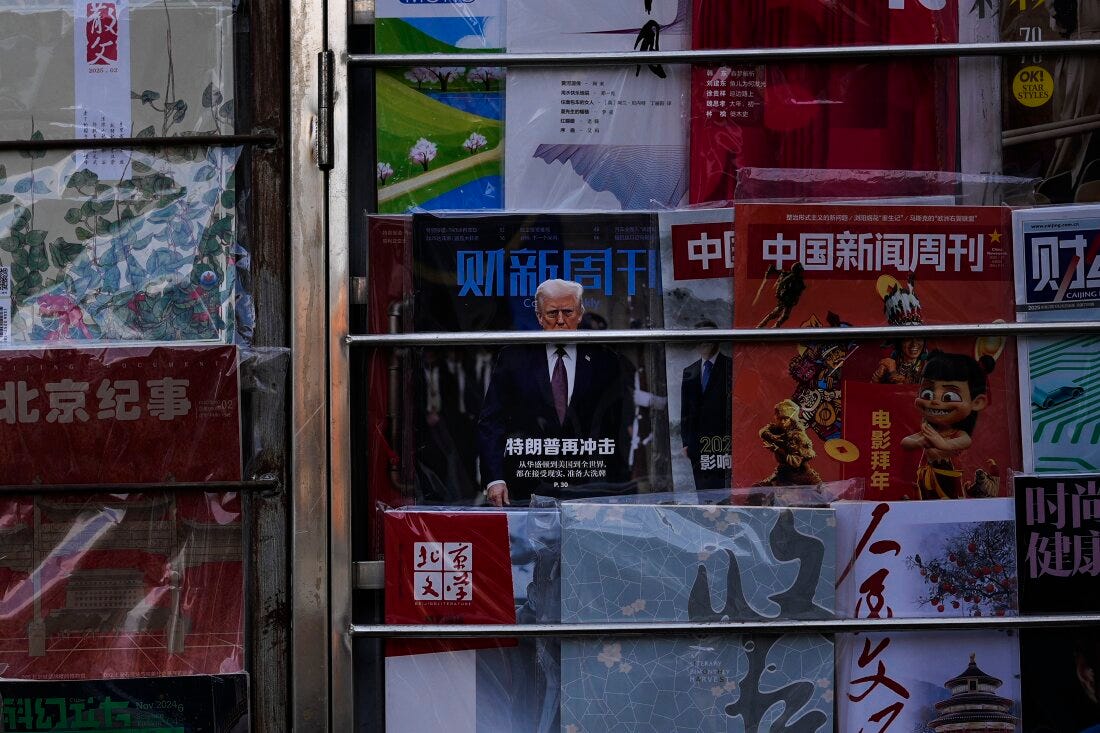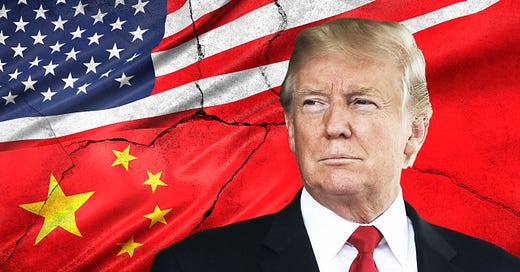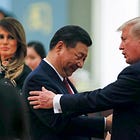China Can't Afford a Trade War...and Trump Knows It
While the usual suspects wring their hands, the truth is that a trade war could crash China. Trump's timing couldn't be worse for Beijing.
by Rod D. Martin
February 12, 2025
Beijing just rang in the Chinese New Year, but it doesn’t have a lot to celebrate. While the usual suspects in America warn of the “apocalyptic” consequences to Americans of Trump’s new tariffs, in reality, it’s China that’s teetering on the brink.
Trump’s timing is brutal. China’s economy is already straining under the weight of weak consumer demand, a collapsing real estate sector (into which nearly all the public’s savings has gone, and on which their aging population is depending for retirement income), not to mention ballooning local government debt with no obvious means to repay. This will only get worse as China’s working age population quickly ages out, leaving fewer and fewer people to support more and more retirees.
My friend Yi Fuxian, the senior scientist at the University of Wisconsin-Madison who spearheaded the movement against the One Child Policy, estimates that China’s actual population is right at 120 million lower than the government’s official number, virtually all of which discrepancy is overstated working age population. The downward spiral is virtually unstoppable.
A decade ago, China could have absorbed the tariff hit. Now? A trade war might push Beijing to the brink.
The Communist regime is scrambling to respond to Trump’s 10% tariff hike on all Chinese imports. But that’s a losing battle. The U.S. is already diversifying its manufacturing base out of China, and worse still, the percentage of China’s GDP that’s dependent on exports is vastly higher than ours. Trump understands that imbalance all too well.
For now, this is a mere skirmish, not yet a full-blown trade war. But Beijing knows the stakes. Unlike past disputes with Canada and Mexico — U.S. neighbors who can be strong-armed into negotiation — China is a strategic adversary. The tariffs aren’t just about trade; they’re a symptom of a deeper geopolitical and economic confrontation. And China, for all its bluster, is not ready for the fight.
Beijing’s Hollow Retaliation
On paper, China is hitting back. It has slapped its own tariffs — 10% on U.S. coal and LNG, 15% on crude oil, agricultural equipment, and autos. But these imports amount to just $14 billion, a fraction of total U.S.-China trade. More revealing is how Beijing is targeting U.S. tech giants. Investigations into Google, Intel, and Nvidia signal that China knows it has limited options. When you can’t hit back dollar-for-dollar, you resort to regulatory harassment.
China could escalate further by devaluing the yuan or restricting exports of critical rare earth minerals. But Beijing has to be careful. Devaluation will certainly result in even more tariff retaliation; and Trump is already acting rapidly to diversify America’s sourcing of rare earths away from China. China’s response might actually worsen its position.
Beyond the tariff battle, China has a much bigger problem. Its economic model — built on exports, government intervention, and debt-driven growth — is increasingly unsustainable. That would be true even without the prospect of demographic collapse. It can’t afford to antagonize its top customer. And yet that’s exactly what it continues to do.
Pride goeth before a fall.
Trump’s Trade Doctrine: A Direct Hit on China
Unlike past U.S. leaders who tolerated China’s economic warfare, Trump is playing hardball. His view on tariffs is blunt:
“Very simply, it’s if they charge us, we charge them,” Trump said aboard Air Force One. “If they are charging us 130 percent and we’re charging them nothing, it’s not going to stay that way.”
This is the crux of the fight. China has gamed the system for decades — high tariffs, subsidies, forced technology transfers — all while enjoying near-unrestricted access to U.S. markets. Trump is forcing a recalibration.
It’s long overdue. Subsidizing China — a Cold War co-belligerent — and America’s various allies made sense four decades ago. But what’s the case for it now? From Beijing to Berlin, America’s trading partners disproportionately benefit from deals that were never intended to be fair. Why should Germany be able to restrict imports from the U.S. and spend just 1.4% of GDP on its military, while depending on the U.S. market for its exports and military for its defense?
That made a lot of sense in 1949. But it’s been a while since 1949.
Unlike Germany, or Canada or Mexico, China is not an ally. China is America’s single largest threat, with the constant possibility of war over Taiwan and a fast-growing military that requires active U.S. containment. And all of this takes place in a world in which the American Navy provides the global security necessary for export-driven economies to exist at all.
The days of the symbiotic relationship are past. Could they be restored? Perhaps. But not on the old terms.
Trump is seeking to bring some degree of balance to all of this. He knows that all these countries depend much more on America than vice versa. It is likely that his opponents will find it to be less painful to play fair than to fight.
The Façade of Strength
China’s sleek tech sector — EVs, batteries, AI, and semiconductors — creates the illusion of strength. But these industries account for just 13% of GDP. The rest of the economy is a mess. The real estate sector, once China’s economic backbone, is collapsing under the weight of ghost cities and bad debt. Local governments, bloated with unsustainable borrowing, are scrambling for cash.
Consumer spending? Stagnant. Productivity? Falling. And personal savings, just as the country ages into retirement? Evaporating.

Nearly 20 years ago, Premier Wen Jiabao warned that China’s economy was “unbalanced, unstable, uncoordinated, and unsustainable.” He was right then, and it’s worse now. The government’s response? Short-term stimulus, market manipulation, and debt rollovers: anything to delay the reckoning.
But no amount of industrial policy or currency manipulation can mask the fundamental problem: China’s economy is not built for real, sustainable growth. It’s a house of cards, propped up by state control and a reliance on global markets that are finally starting to push back.
The Real Danger: A Full-Blown Trade War
China can withstand this round of tariffs. But if Trump turns up the heat — escalating to 25% tariffs, expanding restrictions on Chinese firms, or enforcing tighter export controls — Beijing will feel real pain.
China is not the economic juggernaut it pretends to be. It’s a nation running on tight margins, dependent on foreign buyers, and addicted to credit-fueled expansion. Its real estate collapse is a slow-motion train wreck, and its consumer market is too weak to replace lost export revenue. The Communist Party fears mass unemployment and social unrest more than anything, and a prolonged trade war could push China toward exactly that scenario.
Meanwhile, the rest of the world isn’t standing still. Japan, South Korea, India, and Vietnam are all aggressively expanding their manufacturing bases, eager to siphon business away from China. Two of those face their own demographic problems, but two do not. And as global companies continue shifting supply chains in response to rising U.S.-China tensions, China’s long-term economic prospects could darken even further.
The Inevitable Showdown
Trump may be the catalyst, but the trade war isn’t about him. It’s about China’s refusal to play fair and the world finally waking up to that fact. As long as Beijing clings to its mercantilist, state-driven economic model, confrontation is inevitable. The question isn’t if trade tensions will escalate—but when.
“America First” means unwinding the Cold War mindset regarding lopsided trade and defense deals. It doesn’t mean pulling back, just re-balancing. China’s problem is that its entire model requires that unsustainable lopsidedness.
Those days are over. Trump’s tariffs are just the opening salvo. And if Beijing underestimates the stakes, it might find that its entire economic house of cards comes crashing down, sooner than later.








Another reassuring piece, regarding global victory for true liberty, fairness and democracy!
Neither can we. We are sinking... fast.